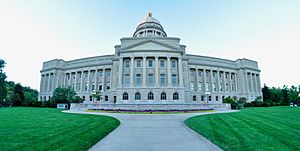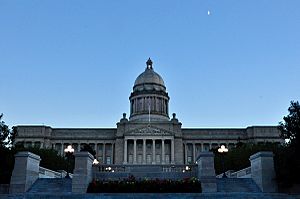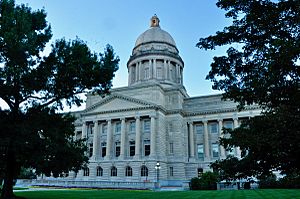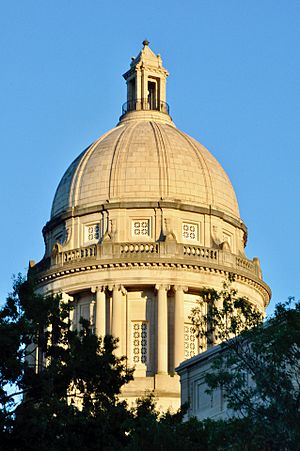Kentucky State Capitol facts for kids
Quick facts for kids |
|
|
Kentucky State Capitol
|
|
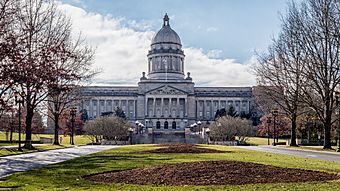
Kentucky State Capitol Front Exterior
|
|
| Location | 700 Capital Avenue, Frankfort, Kentucky |
|---|---|
| Built | 1905–1909 |
| Architect | Frank Mills Andrews |
| Architectural style | Beaux-Arts |
| NRHP reference No. | 73000804 |
| Added to NRHP | April 13, 1973 |
The Kentucky State Capitol is a very important building in Frankfort, Kentucky. It's where the main parts of Kentucky's government work. This includes the governor's office (executive), the lawmakers (legislative), and the state's highest court (judicial). It's also listed on the National Register of Historic Places, which means it's a special historical landmark.
Contents
History of the Capitol Building
Earlier Capitol Buildings
Kentucky has had a few capitol buildings before the current one. From 1792 to 1830, two different buildings served as the capitol. Sadly, both of these buildings were completely destroyed by fire.
In 1830, a new capitol building was constructed. This building was used for many years, until 1910. In 1899, during a very close election for state governor, William Goebel was shot at the capitol. He was on his way to be sworn in as governor. As Kentucky's government grew, a bigger building was needed. The old capitol building is now a museum run by the Kentucky Historical Society.
Building the Current Capitol
In 1904, the Kentucky General Assembly (Kentucky's lawmakers) decided that Frankfort would remain the state capital. They set aside $1 million to build a new, permanent state capitol building. The chosen spot was in southern Frankfort.
Construction officially began on August 14, 1905. The building was finished in 1909, costing about $1.18 million. The Kentucky State Capitol was officially opened on June 2, 1910.
The capitol was designed by Frank Mills Andrews, a famous architect. He used the Beaux-Arts style, which is a grand and classical design. Many parts of the inside look like fancy French buildings. For example, the staircases are copies of those found in the Opéra Garnier in Paris, France.
Statues in the Rotunda
Between 1912 and 1963, five statues of important Kentuckians were placed in the capitol's rotunda. The rotunda is the large, round room under the dome.
- The first statue, a bronze one of Abraham Lincoln, was given in 1912.
- Statues of Henry Clay and Dr. Ephraim McDowell were added in 1930. These are plaster models of the bronze statues that represent Kentucky in the National Statuary Hall in the United States Capitol in Washington, D.C.
- In 1936, a marble statue of Jefferson Davis was placed in the rotunda. Davis was the president of the Confederate States of America. This statue was paid for by donations and public money.
- In 1963, a bronze statue of Alben W. Barkley, a former Vice President of the United States, was added.
In 2018, a plaque in front of the Jefferson Davis statue was removed. It had called Davis a "patriot" and a "hero." On June 4, 2020, Governor Andy Beshear said he thought the Davis statue should be moved. On June 13, 2020, the Kentucky Historic Properties Commission voted to move the statue from the Capitol. The Davis statue was moved to the Jefferson Davis State Historic Site in Fairview, Kentucky, where Davis was born.
Inside the Capitol Building
The main part of the Capitol has three floors, plus a partial fourth floor and a basement.
First Floor Offices
The first floor holds the offices of important state leaders. This includes the governor and their team, the lieutenant governor, the secretary of state, and the attorney general. This floor also has the rotunda, which features statues of famous Kentuckians and other exhibits.
The rotunda has four main statues of important historical figures from Kentucky:
- In the center is a bronze statue of President Abraham Lincoln.
- Along the walls are bronze statues of Henry Clay, Vice President Alben W. Barkley, and Dr. Ephraim McDowell.
Second Floor and Courts
The second floor is home to the courtroom of the Kentucky Supreme Court, which is the state's highest court. The offices for the court's justices are also here. The state law library is located nearby. The beautiful State Reception Room, used for special events, is also on this floor.
Third Floor Chambers
On the third floor, you'll find the main meeting rooms for Kentucky's lawmakers. The chambers for the House of Representatives and the Senate face each other. Some offices for legislative leaders, like the Speaker of the House and the President of the Senate, are also on this floor.
Fourth Floor and Basement
The Capitol also has a partial fourth floor. This floor has galleries where visitors can watch the House and Senate in action. It also has some offices for legislative staff members.
There's also a basement level, which is partly underground. This level mainly has offices for clerks and maintenance workers. However, it also has a small gift shop and a place to grab a quick lunch. A tunnel connects the Capitol to the nearby Capitol Annex building. The Annex has more meeting rooms for lawmakers, their offices, and a cafeteria.
Capitol Security
In the past, the Capitol was completely open during normal business hours. Local people would even use the marble hallways for exercise! Today, anyone without special state ID must go through a metal detector to enter. Security for the Capitol complex is handled by officers from the Facilities Security Branch of the Kentucky State Police and specially assigned state troopers.
Images for kids
See also
 In Spanish: Capitolio del Estado de Kentucky para niños
In Spanish: Capitolio del Estado de Kentucky para niños


